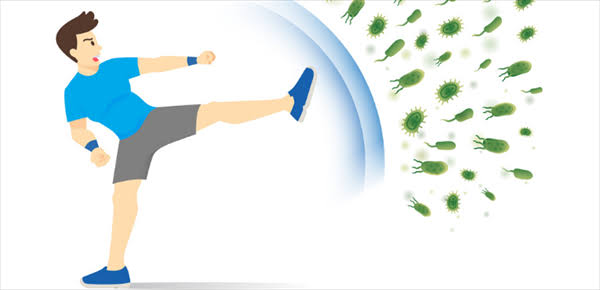
Preparedness planning is essential in order to respond effectively to outbreaks and epidemics. As people seek greater clarity on the risks they can expect to face and how to best minimize them. I prepared guidelines and rules and preventive measures recommended by WHO for us to be always ready and fight against the pandemic novel corona virus.
1. How to Isolate at Home?

If you are returning from an affected area, It is adviced for you to self-isolate for 14 days. Self isolation can help prevent the spread of infections such as novel corona virus (COVID 19).
- Only allow people who live with you to stay.
- Separate yourself from other people – try not to be in the same room as other people at the same time.
- Stay in a well-ventilated room with a window that can be opened.
- Make sure you tell delivery drivers to leave items outside for collection.
- Clean toilets and bathrooms regularly.
- Think about a bathroom rota if a separate bathroom is not available, with the isolated person using the facilities last, before thoroughly cleaning the bathroom themselves.
- Use separate towels from anyone else in the household.
- Wash crockery and utensils thoroughly with soap and water; dishwashers may be used to clean crockery and cutlery.
🔎source: https://www.weforum.org/agenda/2020/03/coronavirus-covid-19-isolation-virus-disease/
2. Keep your distance but stay close

Taking the time to connect with friends and family to strengthen connections will help us get through this pandemic. But in a way we limit ourselves to face-to-face contact with others. Social distancing, also called “physical distancing,” means keeping space between yourself and other people outside of your home. To practice social or physical distancing:
- Stay at least 6 feet (about 2 arms’ length) from other people
- Do not gather in groups
- Stay out of crowded places and avoid mass gatherings
🔎source: https://www.cdc.gov/coronavirus/2019-ncov/prevent-getting-sick/social-distancing.html
3. Proper Use of Face Mask
When you hear about face masks for COVID-19 prevention, it’s generally three types:
- homemade cloth face mask
- surgical mask
- N95 respirator
Let’s explore each of them in a little more detail below.
Homemade face masks

Homemade face masks only offer a small degree of protection, but they may help prevent the spread of SARS-CoV-2 from asymptomatic people. The DOH recommends using them in public settings, as well as practicing social distancing and proper hygiene.
NOTE: Wash homemade cloth masks after every use. When removing, be careful not to touch your eyes, nose, and mouth. Wash hands immediately after removing.
N95 Respiratiors

An N95 respirator is a more tight-fitting face mask. In addition to splashes, sprays, and large droplets, this respirator can also filter out 95 percentTrusted Source of very small particles. This includes viruses and bacteria.
Surgical masks

Surgical masks are disposable, loose-fitting face masks that cover your nose, mouth, and chin. They’re typically used to:
- protect the wearer from sprays, splashes, and large-particle droplets
- prevent the spread of potentially infectious respiratory secretions from the wearer to others
WHEN TO USE FACEMASK

- If you are healthy, you only need to wear a mask if you are taking care of a person with COVID-19.
- Wear a mask if you are coughing or sneezing.
- Masks are effective only when used in combination with frequent hand-cleaning with alcohol-based hand rub or soap and water.
- If you wear a mask, then you must know how to use it and dispose of it properly.
HOW TO PUT ON, USE, TAKE OFF AND DISPOSE A MASK

- Before putting on a mask, clean hands with alcohol-based hand rub or soap and water.
- Cover mouth and nose with mask and make sure there are no gaps between your face and the mask.
- Avoid touching the mask while using it; if you do, clean your hands with alcohol-based hand rub or soap and water.
- Replace the mask with a new one as soon as it is damp and do not re-use single-use masks.
- To remove the mask: remove it from behind (do not touch the front of mask); discard immediately in a closed bin; clean hands with alcohol-based hand rub or soap and water.
https://www.healthline.com/health/coronavirus-mask#types-of-masks
4. Proper Handwashing

Hands are the primary carriers of dirt, viruses, and bacteria, as they can come into contact with so many different surfaces throughout the day. Without proper hand washing, it may cause invasion of bacteria entering the body or cross contamination. Unfortunately, many people don’t know how to properly wash their hands or don’t make the necessary effort. So I’m sharing the correct 7 steps which I always do and recommended by DOH.
7 Steps of Handwashing

Step 1: Wet Hands
Wet your hands and apply enough liquid soap to create a good lather. The temperature of the water should be between 35ºC and 45ºC.
Step 2: Rub Palms Together
Rub your hands palm to palm in circular motions. Rotate clockwise and anticlockwise.
Step 3: Rub the Back of Hands
With your fingers linked through the other hand, use your right palm to rub the back of your left hand. Then swap.
Step 4: Interlink Your Fingers
Link your fingers together, facing each other, into clasped hands. Then rub your palms and fingers together.
Step 5: Cup Your Fingers
Cup your fingers together, with your right hand over and your left hand under. With your fingers interlocked, rub the backs of them against your palms. Then swap.
Step 6: Clean the Thumbs
Enclose your right hand around your left thumb and rub as you rotate it, then swap.
Step 7: Rub Palms with Your Fingers
Rub your fingers over your left palm in a circular motion, then swap.
Once you’ve followed these hand washing steps, you should then thoroughly rinse with warm running water and dry with a clean, disposable paper towel.
🔎source: https://www.highspeedtraining.co.uk/hub/7-steps-of-hand-washing-poster/
5. Stay Healthy

A. Eat healthy
Consume at least five servings of fruits and vegetables every day. Fruits and veggies are loaded with Vitamin C. This vitamin is one of the biggest immune system boosters of all. In fact, a lack of vitamin C can even make you more prone to getting sick. Foods rich in vitamin C include citrus fruits like oranges, dalandan or “ukban” and lemon. They are also rich in folate (folic acid) and dietary fiber and other antioxidants. Green leafy vegetables like malunggay, camote tops, and alugbati are also good sources of dietary fiber, Vitamins A, C and K, and minerals such as iron and calcium that help boost our immune system along with fruits.
Load yourself with foods rich in Vitamin A. This immune boosting vitamin can be sourced from sweet potatoes, carrots, broccoli, spinach, red bell peppers, eggs, and vitamin A fortified foods like milk and cereals.
Include foods high in Vitamin E in your daily diet. This vitamin improves immune function by neutralizing free radicals. Vegetable oils, nuts such as peanuts, almonds, seeds and green leafy vegetables are rich source of this essential vitamin.
Do not forget Zinc. This mineral helps the immune system and wards off viruses. Zinc can be sourced from meats, shellfish, legumes like beans, seeds. nuts, dairy products, eggs and whole grains.
The WHO has also been reminding the public to be wary of raw food. It is therefore recommended to lessen the consumption raw or uncooked foods and avoiding crowded areas as much as possible to lessen the possibility of acquiring such infections.
B. Exercise and be physically active

Another healthy reminder is to exercise and be physically active. Exercise and physical activities help maintain the ideal body weight as well as reduces blood sugar and cholesterol level. At least 30 minutes of exercise or an hour of physical activity is recommended daily.
C. Keep hydrated

Keeping our body hydrated is one very essential reminder to fight against infections. Fluids in the body needs to be constantly replenished to keep your tissues healthy. So, don’t forget to bring your bottle of water for your daily eight (8) glasses of water.
D. A good rest is a must

Healthy diet and regular exercise partnered with a well-rested body does not only strengthen the immunity but also improves cardiovascular health, lowers blood pressure, helps control body weight, and protects against a variety of diseases including viral infections. Therefore, remember to have eight hours of sleep every day.
🔎source: https://www.google.com/amp/s/pia.gov.ph/features/articles/1034995.amp

“Peace I leave with you; my peace I give you. I do not give to you as the world gives. Do not let your hearts be troubled and do not be afraid.”
As the world endures quarantines, closures, and even panic during the coronavirus pandemic, God offers peace. His Word can displace anxiety and fear with hope and healing. Let us be together fight coronavirus and together we all find peace.

